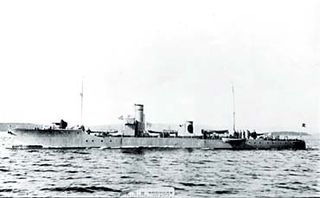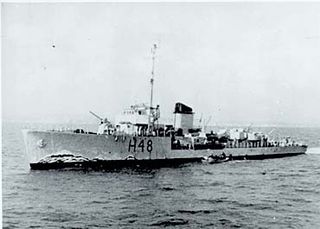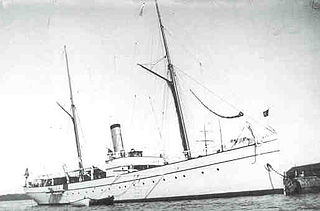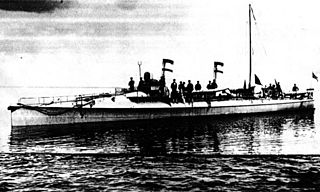
The Royal Norwegian Navy is the branch of the Norwegian Armed Forces responsible for naval operations of Norway. As of 2008, the Royal Norwegian Navy consists of approximately 3,700 personnel and 70 vessels, including 4 heavy frigates, 6 submarines, 14 patrol boats, 4 minesweepers, 4 minehunters, 1 mine detection vessel, 4 support vessels and 2 training vessels. It also includes the Coast Guard.
The German operation for the invasion of Denmark and Norway in April 1940 was code-named Weserübung, or "Weser Exercise." Opposing the invasion were the partially mobilized Norwegian military, and an allied expeditionary force composed of British, French, and Free Polish formations. The following list formed the order of battle for this campaign.

HNoMS Trygg was a torpedo boat of the Royal Norwegian Navy. Her hull was built in Moss and she was finished in Horten, with build number 109. Trygg had two sister ships: HNoMS Snøgg and HNoMS Stegg. Together the three vessels formed the Trygg class of torpedo boats.

The destroyer HNoMS Troll, known locally as Torpedojager Troll, was the second destroyer built for the Royal Norwegian Navy, as the second ship of the Draug-class destroyers. She was built at the naval shipyard in Horten, with yard number 104. She was kept in service long after she was obsolete, and took part in the defence of Norway after the German invasion in 1940.

HNoMS Uller was a Vale-class Rendel gunboat constructed for the Royal Norwegian Navy at Karljohansverns Verft Naval Yard in Horten in 1874-1876 and had yard build number 55. She was one of a class of five gunboats - the other ships in the class were Vale, Brage, Nor and Vidar.
The HNoMS Gor was a Gor-class Rendel gunboat built for the Royal Norwegian Navy at Karljohansvern Naval Yard in Horten in 1884. She was one of a class of two gunboats - the other ship in her class being Tyr. The Gor and Tyr can be seen as improved Vale-class gunboats.
HNoMS Tyr was a Gor-class Rendel gunboat built for the Royal Norwegian Navy at Karljohansverns Verft Naval Yard in Horten. She was laid down in 1884 and launched in 1887 with build number 67. Tyr was one of a class of two gunboats - the other ship in her class being HNoMS Gor. Gor and Tyr can be seen as improved Vale-class gunboats, of 290 tons instead of the 250 tons standard for that class.

The minelayer HNoMS Olav Tryggvason was built by the naval shipyard at Horten in the early 1930s and had build number 119. She served in the Royal Norwegian Navy until captured by the Germans in 1940. The Germans renamed her first Albatros II, and a few days later Brummer. She was wrecked in a British bombing raid in northern Germany in April 1945.

HNoMS Kjell was the final ship of twenty-seven 2nd class torpedo boats built for the Royal Norwegian Navy, launched at the Royal Norwegian Navy's shipyard in Horten on 12 March 1912 with build number 106. Kjell saw more than 32 years of service, the first 28 years in the Royal Norwegian Navy during the First World War and in the interwar period, the last four in the Kriegsmarine, having been captured in the first days of the 1940 Norwegian campaign. After being rebuilt as a minesweeper by the Germans, she was sunk by Royal Air Force de Havilland Mosquito fighter bombers on 28 September 1944. Divers rediscovered the shipwreck in 2006.

HNoMS Sleipner was a destroyer commissioned into the Royal Norwegian Navy in 1936. The lead ship of the Sleipner class, she gained near-legendary status in Norway by enduring over two weeks of intense air attack by Luftwaffe bombers following the 9 April 1940 invasion of Norway. After the resistance in South Norway started unravelling she made her way over the North Sea to continue the fight against the Germans from exile. After serving as a convoy escort along the coast of the United Kingdom, she was decommissioned in 1944. She was recommissioned in 1948 after being converted to a frigate. Along with her surviving sister ships she was sold for scrapping in 1959.

HNoMS Odin was a Sleipner-class destroyer that entered service with the Royal Norwegian Navy in 1939. She and the other Sleipner-class vessels were built as part of a Norwegian rearmament scheme in the last years leading up to the Second World War. In 1940, she had taken part in protecting Norwegian neutrality, before being caught in the German invasion of Norway on 9 April 1940. After fighting the invasion forces at Kristiansand, she was captured and pressed into Kriegsmarine service for the duration of the war. After the end of the war, she was returned to Norway. In 1948, she and her surviving sister ships were converted to frigates and remained in service until sold for scrapping in 1959.

HNoMS Otra was an Otra-class minesweeper built in 1939 for the Royal Norwegian Navy. Captured by the Germans during the 1940 invasion of Norway and renamed Togo, she was returned to the Norwegians in 1946. Otra remained in service until being sold for scrapping in 1963.

HNoMS Nordkapp was the lead ship of the Nordkapp class of fishery protection vessels. She was launched 18 August 1937 at Horten naval shipyard, with yard number 123. She had one sister ship, HNoMS Senja. Nordkapp was named after the North Cape in Finnmark. As was typical of her class, Nordkapp was very unstable in rough seas and was viewed from the beginning as a second-rate vessel. Nordkapp sailed throughout the Second World War and saw service in several theatres.

HNoMS Heimdal was a Norwegian warship built at Akers mekaniske verksted in Kristiania, Norway in 1892 with build number 137.

HNoMS Sæl was the penultimate vessel of the ten 1. class torpedo boats of the Royal Norwegian Navy. She was built at the Royal Norwegian Navy Shipyard in Horten in 1901, with yard number 85. She was to see close to 40 years service with the Royal Norwegian Navy, taking part in the preparations for war in connection with the dissolution the union with Sweden in 1905, enforcing Norwegian neutrality during the First World War and opposing the German invasion of Norway in 1940. She was lost in battle with Kriegsmarine vessels at Ånuglo in the Hardangerfjord on 18 April 1940.
HNoMS Tor was a Sleipner-class destroyer of the Royal Norwegian Navy that was launched in September 1939. She was under outfitting and testing when Nazi Germany invaded Norway on 9 April 1940. Although scuttled by Norwegian naval personnel to prevent her from being captured by the invading forces, she was soon salvaged by the Germans and put into service with the Kriegsmarine. Under the name Tiger she served out the war as an escort and training vessel, being recovered by the Norwegians in Denmark after the German capitulation in 1945. After the war she was converted to a frigate and served until 1959.
The Battle of Horten Harbour or the Action at Horten was an engagement that occurred on 9 April 1940 during Operation Weserübung when the Germans launched an amphibious assault on Karljohansvern, the Norwegian naval base at Horten. After being initially repulsed by Norwegian naval units, German troops headed overland to outflank the base, forcing it to capitulate.

Albatros was the fourth of six Type 23 torpedo boats built for the German Navy. Completed in 1927, Albatros often served as a flagship of torpedo boat units. The ship made multiple non-intervention patrols during the Spanish Civil War in the late 1930s. After an attack by aircraft of the Spanish Republican Air Force killed German sailors in 1937, she participated in the retaliatory bombardment of Almería.

Kondor was the fifth of six Type 23 torpedo boats built for the German Navy. The boat made multiple non-intervention patrols during the Spanish Civil War in the late 1930s. During World War II, she played a minor role in the attack on Oslo, the capital of Norway, during the Norwegian Campaign of 1940. Kondor spent the next several months escorting minelayers as they laid minefields and damaged heavy ships back to Germany before she was transferred to France around September. She started laying minefields herself that month and continued to do so for the rest of the war. The boat returned to France in 1942 and helped to escort blockade runners, commerce raiders and submarines through the English Channel and the Bay of Biscay. Damaged by a mine shortly before the Allied Invasion of Normandy in June 1944, Kondor was under repair on the day of the landings. Recognizing that she could not be repaired quickly, the boat was decommissioned later that month and was then further damaged by British bombers so that she was declared a constructive total loss.














